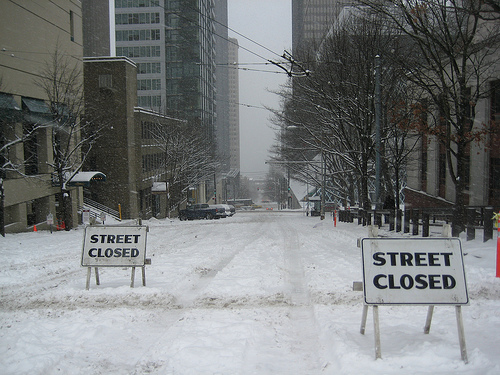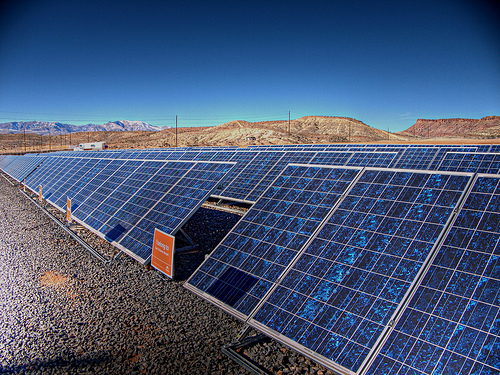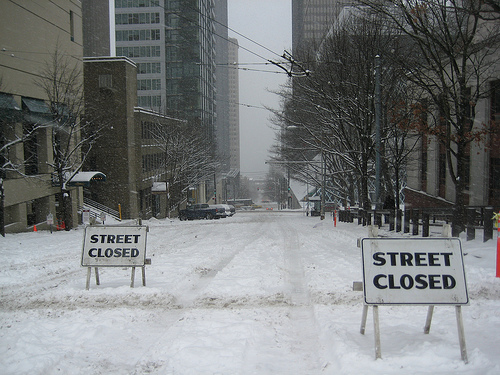 Snowstorms in Seattle, like this one in 2008, highlight how limiting car dependence can be.Photo: John MundyMany people have asked me how I manage with a family and no car. Riding the bus with kids for day-to-day travel is one thing, but what do I do when there’s an emergency or opportunity and I need to get somewhere right away? When I mention the plethora of options I have available to me — cabbing, car sharing, walking, cycling (well, theoretically, anyway), ambulance — in the event I have an immediate need and the bus is not available or practical, people tend to look skeptical. Worried, even. That’s because what they’re really asking is, how do I deal with the lack of control associated with not having a car?
Snowstorms in Seattle, like this one in 2008, highlight how limiting car dependence can be.Photo: John MundyMany people have asked me how I manage with a family and no car. Riding the bus with kids for day-to-day travel is one thing, but what do I do when there’s an emergency or opportunity and I need to get somewhere right away? When I mention the plethora of options I have available to me — cabbing, car sharing, walking, cycling (well, theoretically, anyway), ambulance — in the event I have an immediate need and the bus is not available or practical, people tend to look skeptical. Worried, even. That’s because what they’re really asking is, how do I deal with the lack of control associated with not having a car?
It’s a fair question. Unfortunately, in order to answer it, I am forced to bring up a topic that has received a bit too much attention in my hometown this week. I apologize in advance to all you Seattle types who are sick to death of all the talk of cold weather — and to all you East Coast and Midwest people who can’t understand why we get so worked up about it.
Last week, it snowed in Seattle. As you may or may not know, snow in Seattle is a big deal. (Watch it in the comments, folks; I’m third generation and proud.) There are many reasons for this. In the first place, it doesn’t happen very often, so the city hasn’t invested much in plows, salting trucks, and whatever the heck else you need to clear the streets of the pesky stuff. (We have the equipment, just not much of it.) In the second place, we have hills. The hills are not small. Big hills + partially plowed streets + folks who don’t see snow very often = well, snOMG.
During a Seattle snowstorm, it’s darn near impossible to get around town in a car. This doesn’t stop people from trying. Some people make it there and back without much trouble. Some end up stranded in snowdrifts miles from their homes. Many never make it out of their driveways. For as long as there is snow on the streets, the news is dominated by coverage of snarled traffic, canceled events, and crazy 10-car pileups.
It’s during the times we are not able to drive that it becomes clear just how little “control” a car-dependent life provides. Driving a mile or more to buy a gallon of milk or a box of Band-Aids may not seem especially remarkable until your alternator dies. Or gas prices rise above $4 per gallon. Or the roads are covered in a foot of snow.
When I was in my late teens, my family moved from the city to a northern suburb. During one of my winter break visits home from college, we experienced a huge snowstorm — much bigger than the one last week — and none of the streets in the neighborhood were cleared. While we were trapped in the house together, every one of us came down with an awful flu, and the medicine cabinet was bare. Unfortunately, there wasn’t a single store within walking distance — not that there were sidewalks to walk on. We remained miserable, sick, and claustrophobic for an entire week, until the weather finally warmed and the snow melted.
These days, I’m back in the city (thankfully, so is the rest of my family), and my experience with snowstorms is much different. Cleared roads or not, if I need something (food, medicine, a book, a drink), I don’t have to get in a car — or even, for that matter, on a bus. Our neighborhood ain’t the swankiest or most walkable in Seattle, but we do have a supermarket, a drugstore, and a library. (We also have a beauty supply store, but so far, I haven’t experienced any leave-in conditioner crises during an extreme weather event.) And, despite the fact that my fellow citizens always seem to miss the memo about shoveling them, we have sidewalks.
My neighborhood and its sidewalks also come in handy when it’s not snowing.
I used to worry about what I would do if one of my kids suddenly needed medical care, until I realized that I could walk to a hospital faster than many people I know could drive to one. Not that I would walk, of course. We took a cab when my daughter had an unexplained high fever in the middle of the night — and when I was in labor with my son. Both times, we were checking in within 15 minutes of placing the call. The community clinic where we take the kids for regular care is a block away, and we’re blocks from a pharmacy should we ever require medications we don’t have on hand.
And it’s not just about medical issues. Living in a central city, even one in which cars are the default mode of transportation, means you’re never far from what you need. Our daughter’s preschool is a nine-minute walk (at three-year-old’s pace) from our home. Church is 15 minutes. Grocery store and dry cleaner: seven. Library: five. Post office: 10. Parks and community centers are a few minutes in almost any direction. Downtown is a short bus ride or a really long walk.
My family doesn’t have a car, but what we do have is access, and that makes me feel far more in control than a car ever could.




